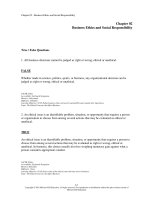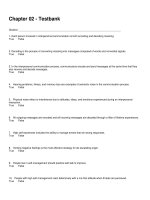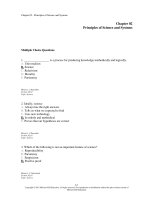Lesikars business communication connecting in a digital world 13th edition rentz test bank
Bạn đang xem bản rút gọn của tài liệu. Xem và tải ngay bản đầy đủ của tài liệu tại đây (396.53 KB, 73 trang )
Chapter 02
Communicating Across Cultures
True / False Questions
1.
The ability to work harmoniously with people from other cultures helps in creating a comfortable
and productive workplace.
True
2.
False
According to Geert Hofstede, culture is the collective programming of the mind which
distinguishes the members of one category of people from another.
True
3.
False
Geert Hofstede defines national culture as that component of our mental programming which we
share with more of our compatriots as opposed to most other world citizens.
True
4.
False
An understanding of your communication partner’s cultural roots will greatly enhance your
interpretive and interaction skills.
True
False
2-1
© 2014 by McGraw-Hill Education. This is proprietary material solely for authorized instructor use. Not authorized for sale or distribution
in any manner. This document may not be copied, scanned, duplicated, forwarded, distributed, or posted on a website, in whole or part.
5.
The topography of a country does not influence its culture.
True
6.
Ethnocentrism makes you a better cross-cultural communicator.
True
7.
False
False
Ethnocentrism is the tendency to prefer the ideas of someone else's culture rather than that of
one's own.
True
8.
False
In the United States an up-and-down movement of the head means “no” and a side-to-side
movement of the head means “yes.”
True
9.
False
The use of fingers to indicate numbers varies by culture.
True
False
10. In the United States, people tend to be polychronic.
True
False
11. People from different cultures often vary in their attitudes toward space.
True
False
2-2
© 2014 by McGraw-Hill Education. This is proprietary material solely for authorized instructor use. Not authorized for sale or distribution
in any manner. This document may not be copied, scanned, duplicated, forwarded, distributed, or posted on a website, in whole or part.
12. Americans belong to a high-context culture.
True
False
13. People from cultures that stress human equality are most likely to quiz a person from another
culture to determine that person’s class status.
True
False
14. Lack of language equivalency exists because there are grammatical and syntactic differences
among languages.
True
False
15. The use of two-word verbs makes it easy for nonnative speakers of English to understand the
language.
True
False
16. The following sentence uses slang. The sales campaign was a failure.
True
False
17. The following sentence uses colloquial language. I'll start the first part of the report, you start the
second, and we'll touch base in a few days.
True
False
18. The reason stereotypes are powerful is that they are based to some degree on observable
likenesses within groups of people.
True
False
2-3
© 2014 by McGraw-Hill Education. This is proprietary material solely for authorized instructor use. Not authorized for sale or distribution
in any manner. This document may not be copied, scanned, duplicated, forwarded, distributed, or posted on a website, in whole or part.
19. Continually checking for shared meaning can hamper the accuracy of the communication process.
True
False
20. Adapting to the cultural practices of one’s international partners might not always be feasible.
True
False
Multiple Choice Questions
21. Which of the following is true about culture?
A. Culture has no effect on the way you communicate.
B. If cultural barriers are maximized, your company will have access to a larger talent pool.
C. Being able to communicate cross-culturally will minimize problems stemming from
misinterpretations.
D. The spread of capitalism and the explosive growth of electronic media have strengthened
national differences.
E. Ethnocentrism makes you a better cross-cultural communicator.
22. Being able to communicate cross-culturally:
A. will hamper the productivity of a workplace.
B. will enrich your business and personal life.
C. requires you to be ethnocentric in your outlook.
D. will maximize the problems stemming from misinterpretations.
E. requires that you favor certain cultural practices over others.
2-4
© 2014 by McGraw-Hill Education. This is proprietary material solely for authorized instructor use. Not authorized for sale or distribution
in any manner. This document may not be copied, scanned, duplicated, forwarded, distributed, or posted on a website, in whole or part.
23. Geert Hofstede defines culture as:
A. the collective programming of the mind which distinguishes the members of one category of
people from another.
B. the abstract system of signs common to every community of the world.
C. the universal system of forms and conventions used by man.
D. that component of our mental programming which we do not share with any of our
compatriots.
E. that component of the human mind which is exclusive to every individual.
24. Geert Hofstede defines national culture as:
A. the abstract system of signs common to every community of the world.
B. the universal system of forms and conventions used by man.
C. that component of the human mind which is exclusive to every individual.
D. that component of our mental programming which we share with more of our compatriots as
opposed to most other world citizens.
E. that component of our mental programming which we share with people from other cultures.
2-5
© 2014 by McGraw-Hill Education. This is proprietary material solely for authorized instructor use. Not authorized for sale or distribution
in any manner. This document may not be copied, scanned, duplicated, forwarded, distributed, or posted on a website, in whole or part.
25. Ethnocentrism is best defined as:
A. the belief that every culture has its own significance.
B. the collective programming of the mind which distinguishes the members of one category of
people from another.
C. the collective programming of the mind which we share with more of our compatriots as
opposed to most other world citizens.
D. the tendency to see only one’s own cultural programming as “normal.”
E. the belief that there is a universal system of forms and conventions underlying the use of human
language.
26. Which of the following statements is true about cultural differences regarding body positions and
movements?
A. In the United States, most people indicate the number “one” by holding up the thumb.
B. Chinese people greet each other with kisses on both cheeks.
C. In the United States an up-and-down movement of the head means “no” and a side-to-side
movement of the head means “yes.”
D. To point to themselves, Americans point to their chests.
E. To point to themselves, the Chinese point to their abdomen.
27. Germans generally offer a handshake that is:
A. brusque and firm with a single pump.
B. moderate in grasp and repeated frequently.
C. firm with three to five pumps.
D. gentle, long-lasting, and sometimes with kisses on both cheeks.
E. light, quick, and sometimes with a double kiss.
2-6
© 2014 by McGraw-Hill Education. This is proprietary material solely for authorized instructor use. Not authorized for sale or distribution
in any manner. This document may not be copied, scanned, duplicated, forwarded, distributed, or posted on a website, in whole or part.
28. British nationals generally offer a handshake that is:
A. brusque and firm, with a single pump.
B. moderate in grasp and repeated frequently.
C. soft, with three to five pumps.
D. strong, long-lasting, and sometimes with kisses on both cheeks.
E. moderate in grasp and includes a double kiss.
29. French nationals generally offer a handshake that is:
A. brusque and firm with a single pump.
B. moderate in grasp and repeated frequently.
C. firm with three to five pumps.
D. strong, long-lasting, and sometimes with kisses on both cheeks.
E. light, quick, repeated upon arrival and departure, and may include a double kiss.
30. Americans generally offer a handshake that is:
A. brusque and firm with a single pump.
B. moderate in grasp and repeated frequently.
C. firm with three to five pumps.
D. light, quick, and sometimes with a double kiss.
E. gentle, long-lasting, and sometimes with kisses on both cheeks.
2-7
© 2014 by McGraw-Hill Education. This is proprietary material solely for authorized instructor use. Not authorized for sale or distribution
in any manner. This document may not be copied, scanned, duplicated, forwarded, distributed, or posted on a website, in whole or part.
31. Hispanics generally offer a handshake that is:
A. brusque and firm with a single pump.
B. moderate in grasp and repeated frequently.
C. firm with three to five pumps.
D. gentle, long-lasting, and sometimes with kisses on both cheeks.
E. light, quick, and sometimes with a double kiss.
32. Which of the following statements is true about cultural differences regarding body positions and
movements?
A. In the United States an up-and-down movement of the head means “no” and a side-to-side
movement of the head means “yes.”
B. Muslims generally accept gifts with the left hand.
C. Touching with the left hand is considered a sign of respect among Muslims.
D. To refer to themselves, the Japanese point to their faces.
E. In Indonesia, looking directly at people, especially those who are older or in higher positions is
considered respectful.
2-8
© 2014 by McGraw-Hill Education. This is proprietary material solely for authorized instructor use. Not authorized for sale or distribution
in any manner. This document may not be copied, scanned, duplicated, forwarded, distributed, or posted on a website, in whole or part.
33. Which of the following is true about the attitudes of cultures toward various factors of human
relationships?
A. In the United States, people tend to be polychronic.
B. In the Middle East, people tend to be monochronic.
C. North Americans tend to prefer about two feet of distance between themselves and those with
whom they speak.
D. North Americans view personal space as belonging to all.
E. In North America, it is considered a sign of disrespect to maintain eye contact when giving
formal speeches.
34. Which of the following is true about the attitudes of cultures toward various factors of human
relationships?
A. In the Middle East, people regard time as something that must be planned in order to be used
as efficiently as possible.
B. North Americans view personal space as a right and tend to respect this right of others; thus,
they stand in line and wait their turn.
C. In North America, it is considered a sign of disrespect to maintain eye contact when giving
formal speeches.
D. In the United States, people are polychronic, viewing time in a more relaxed way.
E. In the United States, people see extensive planning as unwise and unnecessary.
2-9
© 2014 by McGraw-Hill Education. This is proprietary material solely for authorized instructor use. Not authorized for sale or distribution
in any manner. This document may not be copied, scanned, duplicated, forwarded, distributed, or posted on a website, in whole or part.
35. Which of the following is true about the attitudes of cultures toward various factors of human
relationships?
A. In the United States, people are polychronic and view time in a more relaxed way.
B. In the United States, people hold the view that important people should be late to show that
they are busy.
C. In business negotiations, people from the United States move at a deliberately slow pace,
engaging in casual talk before getting to the main issue.
D. North Americans view space as belonging to all; thus, they jostle for space when boarding
trains, standing at ticket counters, or shopping.
E. Americans work hard to neutralize body odors or to cover them up and view body odor as
unsanitary.
36. American people:
A. tend to be polychronic.
B. belong to a low-context culture.
C. consider touching with the left hand as a serious breach of etiquette.
D. tend to be reticent in their relationships with others.
E. tend to communicate implicitly.
37. Which of the following is true about Asians?
A. They belong to a low-context culture.
B. They tend to express themselves explicitly.
C. They tend to be reticent in their relationship with others.
D. They tend to share all relevant background information when communicating.
E. They avoid using a multimodal style when communicating.
2-10
© 2014 by McGraw-Hill Education. This is proprietary material solely for authorized instructor use. Not authorized for sale or distribution
in any manner. This document may not be copied, scanned, duplicated, forwarded, distributed, or posted on a website, in whole or part.
38. Which of the following is true about the attitudes of cultures toward various factors of human
relationships?
A. People belonging to polychronic cultures regard time as something that must be planned in
order to be used as efficiently as possible.
B. Communicators belonging to low-context cultures use a more multimodal style of
communication compared to those from high-context cultures.
C. In individualistic cultures people are expected to look after themselves and their families.
D. People from across cultures hold the common view that space belongs to all.
E. Communicators belonging to high-context cultures tend to express themselves in concrete,
direct, and explicit ways.
39. Which of the following is true about the attitudes of cultures toward various factors of human
relationships?
A. A collectivist culture promotes strong identification with social groups.
B. A company with low power distance will most likely have a strong boss with weak subordinates.
C. In companies where high power distance exists, authority is widely shared and decisions are
often made by consensus.
D. People belonging to polychronic cultures regard time as something that must be planned in
order to be used as efficiently as possible.
E. People from across cultures hold the common view that space belongs to all.
2-11
© 2014 by McGraw-Hill Education. This is proprietary material solely for authorized instructor use. Not authorized for sale or distribution
in any manner. This document may not be copied, scanned, duplicated, forwarded, distributed, or posted on a website, in whole or part.
40. Which of the following is true about linear-actives, multi-actives, and reactives as defined by
Richard D. Lewis?
A. Linear-actives are those who have several things going at the same time.
B. People belonging to polychronic cultures regard time as something that must be planned in
order to be used as efficiently.
C. Multi-actives plan their priorities not according to a time schedule but according to the relative
thrill or importance that each appointment brings with it.
D. Linear-actives are those who do many things at once.
E. Reactives are those who are impulsive and do not act with caution.
41. Which of the following explains why it is difficult to make precise equivalent translations between
languages?
A. Languages are based on the concepts, experiences, and views of the particular cultures that
developed them.
B. A word in one language always has a corresponding word in another language.
C. A word that seems the same in two languages always has the same meanings in both
languages.
D. There are no grammatical and syntactic differences among languages.
E. Like-meaning words are always used in the same way across cultures.
2-12
© 2014 by McGraw-Hill Education. This is proprietary material solely for authorized instructor use. Not authorized for sale or distribution
in any manner. This document may not be copied, scanned, duplicated, forwarded, distributed, or posted on a website, in whole or part.
42. Precise equivalent translations between languages is difficult because:
A. languages are not based on the concepts, experiences, and views of the particular cultures that
developed them.
B. a word in one language always has a corresponding word in another language.
C. of the existence of multiple word meanings.
D. there are no grammatical and syntactic differences among languages.
E. like-meaning words are always used in the same way across cultures.
43. Which of the following sentences has a two-word verb?
A. You must visit the museum.
B. Greg is from Washington.
C. The car broke down last night.
D. Most tourists love this spot.
E. There is a scheduled trip to the zoo now.
44. Which of the following sentences has a two-word verb?
A. My uncle is a mechanic.
B. He is at school.
C. He has six grandchildren.
D. The meeting was called off.
E. The thief managed to escape.
2-13
© 2014 by McGraw-Hill Education. This is proprietary material solely for authorized instructor use. Not authorized for sale or distribution
in any manner. This document may not be copied, scanned, duplicated, forwarded, distributed, or posted on a website, in whole or part.
45. Which of the following sentences uses a two-word verb?
A. The child had an imaginary friend named Mike.
B. Jack planted roses in his garden.
C. He was asked to turn off the lights.
D. The convertible swerved and crashed.
E. She saved the cat from drowning in the lake.
46. Which of the following sentences uses a two-word verb?
A. The dancer was extremely elegant.
B. He sold his apartment after the break up.
C. Her eyes were sparkling.
D. He died in the accident.
E. The old man had a photograph of a woman.
47. Which of the following sentences does not have a two-word verb?
A. The flight took off an hour ago.
B. She will come back next month.
C. You can always depend on John.
D. There was a fire in the forest.
E. I thought the movie was going to end, but it just dragged on.
2-14
© 2014 by McGraw-Hill Education. This is proprietary material solely for authorized instructor use. Not authorized for sale or distribution
in any manner. This document may not be copied, scanned, duplicated, forwarded, distributed, or posted on a website, in whole or part.
48. Which of the following sentences does not have a two-word verb?
A. Look out for snakes in the forest.
B. Smith was asked to stay after class.
C. I was brought up by my aunt.
D. The game was called off.
E. Please fill out this form.
49. Which of the following sentences does not have a two-word verb?
A. We blew up some balloons.
B. The girl with the red hair is pretty.
C. He made up that story.
D. They quickly put out the fire.
E. I’ll put my new dress on.
50. Which of the following sentences does not have a two-word verb?
A. I’m really tired because I didn’t sleep well last night.
B. The show must go on.
C. We ran into some old friends at the mall.
D. The car ran out of gas.
E. Take that cap off!
2-15
© 2014 by McGraw-Hill Education. This is proprietary material solely for authorized instructor use. Not authorized for sale or distribution
in any manner. This document may not be copied, scanned, duplicated, forwarded, distributed, or posted on a website, in whole or part.
51. Which of the following sentences does not have a two-word verb?
A. I expect the sales to take off in November.
B. They tried to cut back on their expenditures.
C. She could not explain the decline in profit.
D. They had a very messy break up.
E. Try to figure out this system.
52. In order to avoid misinterpretations in cross-cultural communication, you should:
A. avoid using two-word verbs.
B. use passive voice instead of active voice.
C. use colloquial expressions.
D. avoid using the active verb.
E. avoid using back translating procedures.
53. Which of the following sentences uses slang or a colloquial word?
A. I would like to compete in a cooking contest.
B. They planned to watch a movie tonight.
C. The basketball team was pumped up for the game.
D. I've decided to extend my membership at the gym.
E. I was about to send you an email.
2-16
© 2014 by McGraw-Hill Education. This is proprietary material solely for authorized instructor use. Not authorized for sale or distribution
in any manner. This document may not be copied, scanned, duplicated, forwarded, distributed, or posted on a website, in whole or part.
54. Which of the following sentences uses a slang word or a colloquial word?
A. I would rather exercise than sit on the couch all day.
B. Her remarks were a bit over the top, don't you think?
C. I'm looking forward to spending time with my family.
D. I have something important to tell you.
E. I was busy thinking of ideas for our website.
55. Which of the following sentences does not contain colloquial expressions?
A. We were up the creek without a paddle.
B. He ran around like a headless chicken.
C. We were tuckered out.
D. I think we are in a rut.
E. We will deliver the package on Friday.
56. Which of the following sentences does not contain slang words or colloquial expressions?
A. Our vacation was a blur because we were having so much fun!
B. He has left for home.
C. I bought a used laptop for 50% off. What a steal!
D. I aced my math test!
E. I was all geared up for the race.
2-17
© 2014 by McGraw-Hill Education. This is proprietary material solely for authorized instructor use. Not authorized for sale or distribution
in any manner. This document may not be copied, scanned, duplicated, forwarded, distributed, or posted on a website, in whole or part.
57. Which of the following sentences does not contain slang words or colloquial expressions?
A. Look at that basket case! He is dancing in the street.
B. The salesman was talking baloney when he told the woman that his new vacuum could clean
her whole house in five minutes.
C. If you don’t back off, I’m going to call the cops!
D. They couldn’t understand the report.
E. I aced my math test!
58. For communicating successfully across cultures, you should:
A. learn all you can about your communication partners' cultures.
B. use two-word verbs.
C. use double questions in conversations for emphasis.
D. use colloquial expressions.
E. use slang words.
59. Which of the following is true about cross-cultural communication?
A. Body language is the same world over and does not affect cross-cultural communication.
B. Ethnocentrism makes you a better cross-cultural communicator.
C. Adapting to the practices of one’s international partners is not always feasible.
D. Continually checking for shared meaning can hamper the accuracy of a communication process.
E. The use of double questions enhances the clarity of messages in cross-cultural communications.
2-18
© 2014 by McGraw-Hill Education. This is proprietary material solely for authorized instructor use. Not authorized for sale or distribution
in any manner. This document may not be copied, scanned, duplicated, forwarded, distributed, or posted on a website, in whole or part.
60. Which of the following is true about cross-cultural communication?
A. Body language is the same world over and does not affect cross-cultural communication.
B. Ethnocentrism makes you a better cross-cultural communicator.
C. The use of two-word verbs enhances the clarity of cross-cultural communications.
D. Continually checking for shared meaning can help ensure the accuracy of the communication
process.
E. The use of double questions enhances the clarity of cross-cultural communications.
61. For communicating successfully across cultures, you should:
A. use yes/no questions often in conversations.
B. use double questions often in conversations.
C. talk slowly and enunciate each word.
D. use negative questions in conversations for emphasis.
E. use colloquial words.
62. For communicating successfully across cultures, you should:
A. avoid the frequent use of yes/no questions in conversations.
B. use double questions often in conversations.
C. avoid the use of active voice.
D. use negative questions in conversations for emphasis.
E. use colloquial words.
2-19
© 2014 by McGraw-Hill Education. This is proprietary material solely for authorized instructor use. Not authorized for sale or distribution
in any manner. This document may not be copied, scanned, duplicated, forwarded, distributed, or posted on a website, in whole or part.
63. For communicating successfully across cultures, you should:
A. frequently use yes/no questions in conversations.
B. use double questions often in conversations.
C. avoid using the active voice.
D. avoid using negative questions in conversations.
E. use colloquial words.
64. For communicating successfully across cultures, you should:
A. frequently use yes/no questions in conversations.
B. avoid using double questions.
C. avoid using the active voice.
D. use negative questions in conversations to emphasize the content.
E. use colloquial words.
65. Which of the following is true about cross-cultural communication?
A. Body language is the same world over and does not affect cross-cultural communication.
B. Ethnocentrism makes you a better cross-cultural communicator.
C. The use of colloquial expressions enhances the clarity of cross-cultural communications.
D. The use of open-ended questions in conversations can enhance the effectiveness of crosscultural communication.
E. Continually checking for shared meaning can hamper the accuracy of a communication process.
Short Answer Questions
2-20
© 2014 by McGraw-Hill Education. This is proprietary material solely for authorized instructor use. Not authorized for sale or distribution
in any manner. This document may not be copied, scanned, duplicated, forwarded, distributed, or posted on a website, in whole or part.
66. Why is effective cross-cultural communication important to businesses?
67. Describe the three major factors that influence a country or region’s culture.
2-21
© 2014 by McGraw-Hill Education. This is proprietary material solely for authorized instructor use. Not authorized for sale or distribution
in any manner. This document may not be copied, scanned, duplicated, forwarded, distributed, or posted on a website, in whole or part.
68. Discuss how hand gestures differ in meaning across cultures.
69. Differentiate between high-context and low-context cultures.
2-22
© 2014 by McGraw-Hill Education. This is proprietary material solely for authorized instructor use. Not authorized for sale or distribution
in any manner. This document may not be copied, scanned, duplicated, forwarded, distributed, or posted on a website, in whole or part.
70. Differentiate between high power distance and low power distance cultures.
71. Differentiate between individualism and collectivism.
2-23
© 2014 by McGraw-Hill Education. This is proprietary material solely for authorized instructor use. Not authorized for sale or distribution
in any manner. This document may not be copied, scanned, duplicated, forwarded, distributed, or posted on a website, in whole or part.
72. Explain the label uncertainty avoidance related to cultures
73. Describe Richard D. Lewis' three-part model for categorizing our world’s many cultures.
2-24
© 2014 by McGraw-Hill Education. This is proprietary material solely for authorized instructor use. Not authorized for sale or distribution
in any manner. This document may not be copied, scanned, duplicated, forwarded, distributed, or posted on a website, in whole or part.
74. Define two-word verbs with an example.
75. Why is stereotyping regarded as negative?
2-25
© 2014 by McGraw-Hill Education. This is proprietary material solely for authorized instructor use. Not authorized for sale or distribution
in any manner. This document may not be copied, scanned, duplicated, forwarded, distributed, or posted on a website, in whole or part.









